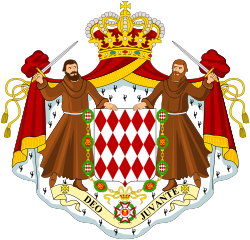Powers of the prince
Monaco, along with Liechtenstein and Vatican City, is one of only three states in Western Europe where the monarch still plays an active role in day-to-day politics.
The Prince of Monaco exercises his authority in accordance with the Constitution and laws. He represents the principality in foreign relations, and any revision, either total or partial, of the Constitution must be jointly agreed to by the monarch and the National Council. [4]
Legislative power is divided between the Prince who initiates the laws, and the National Council which votes on them. Executive power is retained by the monarch, who has veto power over all legislation proposed by the National Council. [2]
The minister of state and the Government Council are directly responsible to the Prince for the administration of the principality. [4]
Judiciary powers also belong to the monarch. The present Constitution states that the prince has full authority in the courts and tribunals which render justice in his or her name. [4]
Pursuant to Article 16 of the 1962 Constitution, the Prince confers orders, titles and other distinctions (see Awards and decorations of Monaco) as the fons honorum of the Principality of Monaco. [4]
In 2005, The New York Times reported that loyalty to the princely family is fierce; few residents of Monaco want to be quoted saying anything negative about the monarchy. [3]
Titles and styles
The Prince is styled His Serene Highness. [6] Although used only formally, the Prince also bears several other hereditary titles, some of which are occasionally bestowed on his relatives or their spouses. Some of these titles have merged with the Crown of Monaco as a result of the Grimaldi family's acquisition of various fiefs; [6] they no longer imply ownership or territorial authority, although the princes of Monaco have long been substantial owners of land and chateaux in France. Most were granted or recognised by the Kingdom of France or the Papal States and could only pass through the male line; they therefore became extinct as French dignities on the death of Albert's great-grandfather Prince Louis II in 1949. Thereafter, some of these titles were implicitly re-created as distinctly Monegasque titles. [6]
The Prince's complete titles and styles are, in precedent order of rank:
All palace correspondence features capitalized pronouns when referring to the prince. [7]
The tradition of the monarchy of Monaco was that the flag flying from the staff on the tower above his office be hoisted when the prince was present in Monaco. [7] The current prince flies the flag whether he is present or not, preferring to keep his location private. [7]
Monaco is officially protected by France, according to terms set forth in the Treaty of Versailles in 1919. [2]
This page is based on this
Wikipedia article Text is available under the
CC BY-SA 4.0 license; additional terms may apply.
Images, videos and audio are available under their respective licenses.


